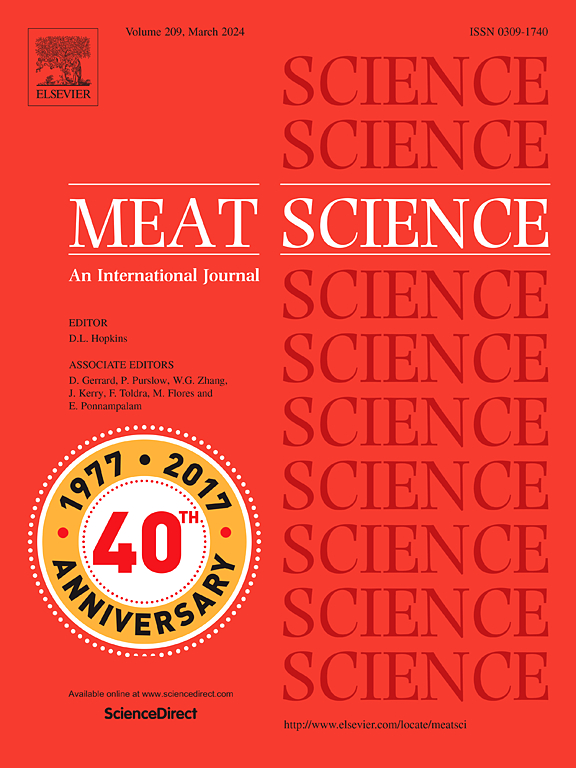Effects of space allowance, roughage supplement, and enrichment provision on growth, carcass weight and meat quality in conventional indoor pig husbandry
IF 6.1
1区 农林科学
Q1 Agricultural and Biological Sciences
引用次数: 0
Abstract
Extensification of indoor pig husbandry is increasingly under focus, but effects on meat quality remain to be determined. This study investigated the effects of extensification factors on growth, carcass weight and meat quality of fattening pigs. Three factors were studied on pigs from 30 kg up to slaughter at approximately 120 kg: increase space allowance to 1.4 (S9, n pigs = 108, n samples = 42) or 2.1 (S6, n pigs = 72, n samples = 42) m2 per pig, provision of various enrichments (E, n pigs = 114, n samples = 44), and daily provision of roughage (R, n pigs = 115, n samples = 45). Treatments were compared to a control group with 0.7 m2 per pig and no extra enrichment nor roughage (C, n pigs = 115, n samples = 48). The study was performed over two batches, in spring and in autumn. The treatments had overall no effect on meat quality as measured by temperature and pH, colour, driploss, cooking loss or texture. However, the meat from S9 pigs had a significantly lighter colour than the meat from C, R or E and in addition, pigs from S6 had a higher growth rate (ADG) and carcass weight than C and R. Overall, the treatments had little to no effect on meat quality but increasing space allowance by a factor three notably improved pig growth. In contrast, the experimental batch significantly influenced several parameters of meat quality as well as growth and carcass weight, highlighting that un-controlled factors varying between batches, including seasonal effects, had a greater impact on meat quality than the treatments alone.
空间裕度、粗饲料补充和富集对常规室内养猪生长、胴体重和肉质的影响
室内养猪业的推广日益受到关注,但对肉质的影响仍有待确定。本试验研究了不同扩展因子对育肥猪生长、胴体重和肉品质的影响。从30公斤到屠宰约120公斤的猪,研究了三个因素:将空间允许增加到每头猪1.4 (S9, n头= 108,n样本= 42)或2.1 (S6, n头= 72,n样本= 42)m2,提供各种丰富物质(E, n头= 114,n样本= 44),以及每日提供粗饲料(R, n头= 115,n样本= 45)。对照组每头猪饲喂0.7 m2,不添加饲料和添加饲料(C, n头猪= 115头,n份样品= 48头)。研究分两批进行,分别在春季和秋季进行。从温度和pH值、颜色、滴落、蒸煮损失或质地等方面衡量,这些处理对肉质总体上没有影响。S9猪的肉色明显较C、R和E猪浅,S6猪的生长率和胴体重均高于C和R猪。总体而言,各处理对肉质影响不大,甚至没有影响,但增加1 / 3的空间裕度显著改善了猪的生长。相比之下,试验批次显著影响了肉品质、生长和胴体重等几个参数,突出表明批次之间不同的不可控因素(包括季节效应)对肉品质的影响大于单独处理。
本文章由计算机程序翻译,如有差异,请以英文原文为准。
求助全文
约1分钟内获得全文
求助全文
来源期刊

Meat Science
工程技术-食品科技
CiteScore
12.60
自引率
9.90%
发文量
282
审稿时长
60 days
期刊介绍:
The aim of Meat Science is to serve as a suitable platform for the dissemination of interdisciplinary and international knowledge on all factors influencing the properties of meat. While the journal primarily focuses on the flesh of mammals, contributions related to poultry will be considered if they enhance the overall understanding of the relationship between muscle nature and meat quality post mortem. Additionally, papers on large birds (e.g., emus, ostriches) as well as wild-captured mammals and crocodiles will be welcomed.
 求助内容:
求助内容: 应助结果提醒方式:
应助结果提醒方式:


